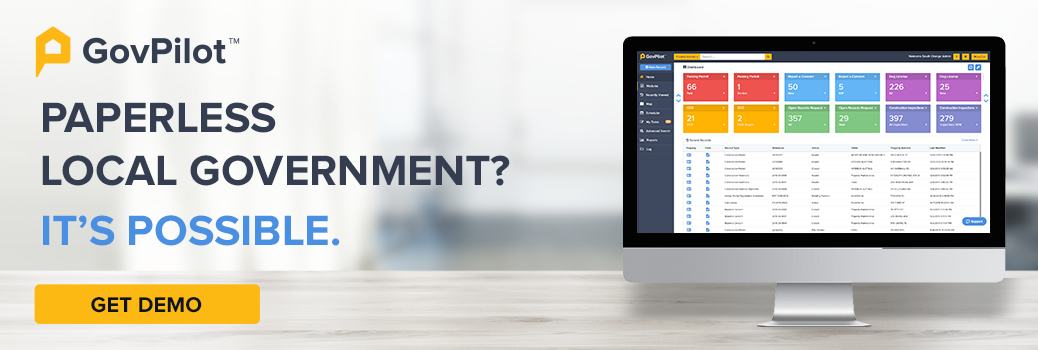Local government leadership constantly needs to consider the impact of current public endeavors, the status of local assets like infrastructure, and which policies to prioritize in future budget allocation. Yet, without modern analytics, tracking progress and using it to make informed decisions is far from easy.
Luckily, local government technology makes it easy to track and analyze your government’s performance across departments and goal-types, so that you have data-backed knowledge of how government projects are going and what challenges your future budget expenditures should address.
Read on for everything you need to know about modern government analytics and how they can help with assessing performance and making decisions.
What are Government Analytics?
As defined by Technopedia, analytics is the, ”scientific process of discovering and communicating the meaningful patterns which can be found in data.” In government, analytics can be set up to track actual performance against goals (known as key performance indicators) to recognize where your government is excelling and where it is failing to meet objectives.
Why are Government Analytics Important?
Taking guesses at the status of government progress is a sure way to underdeliver for your constituents and lose re-election or lose out on economic development. You owe it to your community to have concrete evidence of government expenditures such as project timeframes, budget allocation, public priorities, and more.
Proper government analytics automates the evidence-collection process, allowing you to see real time data across projects and government departments, and hold government officials and private sector partners accountable if deadlines, budgets, etc. aren’t on par with the set goals. And if things are going according to plan, or doing better than expected as far as timeframes and budgets are concerned, data collected from your analytics set up can be made public to let community-members know that your local government is doing a great job!
How Can Your Local Government Utilize Modern Analytics?
Many local governments are making a digital transformation as a means to streamline their government analytics. By implementing government management software across government departments, all of your government data will be automatically pulled into the cloud.
Once you’ve established your local government KPIs, customized dashboards highlighting anything from budgets to project timeframes will pull in relevant metrics in real time for your local leadership to use.
Consider GovPilot's guide on Political & Government Agency Press Release Format & Strategy to share important information with constituents.
What Type of Data Can Government Analytics Track?
The beauty of customizable government dashboards and reports is that your local government can pay attention to the metrics that matter most to your municipality and constituents.
Here is a high-level overview of some types of data that can collected with government analytics and how you can use it to make informed decisions:
1. Budgeting Across Departments
Whether you’re using taxpayer dollars or federal grants to pursue local government projects, having limited funds means that your locality needs to come in at or under budget.
Luckily, government analytics pulls all of your financial data into relevant dashboards, allowing you to see a macro view of where money is being spent in each department as well as a look at where money is being allocated on specific government projects and private-sector partners.
2. Project Timelines
Too many private-sector partners and government officials fail to deliver on time when it comes to government projects. When hiring contractors for infrastructure projects, you’ll be able to use GovPilot to view timelines in an intuitive gantt chart structure, and have a clear view into whether or not projects are going to be completed by the initial deadline. What better way to hold partners accountable?
3. Fee & Fine Collection
A great deal of your government budget likely comes from fees for things like license and permit applications as well as fines for code violations. Government analytics can pull financial data into a clear cut financial dashboard that showcases which fee and fine types are generating the most revenue for your locality and whether or not you're hitting budgetary goals from things like permit application fees.
Data from fines can be used to make decisions about local infrastructure improvements too. If people in a particular neighborhood are constantly receiving tickets for parking illegally, that indicates that the establishment of a public parking area in that part of the community could help.
Learn more about Fee & Fine Processing for Local Governments.
4. Employee Recruitment & Retention
As the Great Resignation continues, many local governments are experiencing difficulty in recruiting and retaining government workers. With analytics set-up via government Human Resources department software, there will be clear cut insight into how long job roles remain open as well as how long employees are staying on average.
Read on for more local government HR tips:
- Local Government Human Resources Guide: Hiring & Retaining Government Workers
- How to Recruit Local Government Employees
- How to Get People to Volunteer and Work at Your Local Government
5. Concerns from the Public
Embracing local government digital transformation means your locality will have access to complaint management software. With this technology, community-members can file formal complaints with their local government for non-emergency issues straight from their cell phone.
Every time a complaint is filed, analytics tracking will pull the data into a complaint management dashboard, allowing your locality to have clear insight into which issues matter most and need to be addressed. Learn more about building a Complaint Management Strategy for Local Governments.
6. Types of Applications Being Submitted
Is there an increase in construction permits being filed in your community? Are people filing for licenses to utilize public spaces for events? Are more businesses being registered? Are people requesting public records? Government analytics allows you to get clear cut data into the quantity of each application type that are being submitted by local businesses and community-members, allowing you to have clear insight into local economic development.
7. Property Records
With the power of 3D GIS mapping, any record pertaining to a specific residential or commercial property can be accessed at the touch of a screen. With government software pulling data into each property in real time, government leadership can look at records regarding the following:
- Building inspections
- Code violations
- Vacant properties
- Health department inspections
- Business registration (including cannabis dispensary registration)
- Short-term and long-term rentals
- All related licenses and permits
8. Asset Management
Data can be recorded and showcased to highlight the quality of government assets and local infrastructure. Doing so allows your local government leadership to have a clear idea of which assets are in most dire need of maintenance or replacement.
How to Get Government Analytics Set-Up
If you’re hearing about all of this insightful data and feeling like you’re missing out, you're not alone. Many local governments continue to use antiquated methods that don’t allow them to harness the power of data collection and government dashboards.
Luckily, getting your data analytics set up is easier than it seems. If you’re looking for data collection for a particular department (or several high-priority departments) you can opt to start with 5 GovPilot modules for your relevant department(s). That being said, if you want transparent data across departments that can be streamlined into a array of custom reports and dashboards, your best bet is to go for the unlimited modules option, which will give you access to the full GovPilot government software suite across departments AND give you the option to work with GovPilot’s team of engineers to create new, customized government tech solutions.
To learn more about how GovPilot can transform your local government, book a free demo.
Government Analytics FAQs
What is Local Government Analytics?
Local government analytics is the collection of data within a community to track progress, measure progress against preset goals, and make educated decisions for the future. Historically, data was manually uploaded to databases from paper forms. More recently, cloud-based government software moves government forms online, allowing localities to collect and analyze data in real time when documents are submitted via your government website.
Why Do Local Governments Need to Collect Data?
The collection of data at scale paints a clear picture of what’s happening in your town, how much time government projects are taking, and where budgets are being allocated across government departments. By collecting data across departments, the information that is conveyed can be pulled into intuitive dashboards and reports.
How Can Government Officials Analyze Data to Make Informed Decisions?
Local government officials can analyze data that’s pulled into various dashboard types, including:
- Financial dashboards: where revenue is being generated and how government funds are being allocated
- Project timelines: see visuals around how projects are coming along compared to the original deadlines.
- Human resources dashboard: see how long employees are sticking around and how long roles are staying open on average.
- Public complaints: look at patterns to determine which issues matter most to your citizens and their perception on how your local government is doing.
How to Share Government Data Publicly?
Federal and state level open record policies require local governments to make public sector documents and data accessible to the public. For open records that are regularly requested like court documents and other departmental records.
As for data that showcases public efforts and expenditures in a positive light, your local government can share reports and dashboards with the press to highlight all of the great work your locality has been focused on pursuing.







